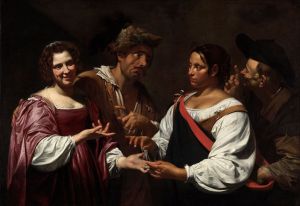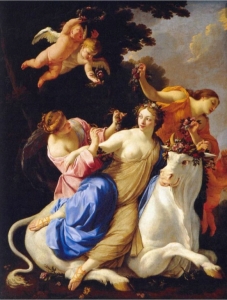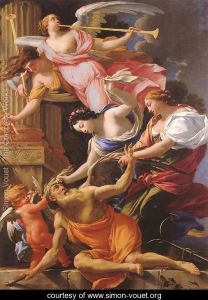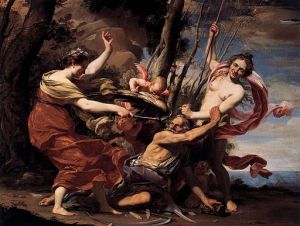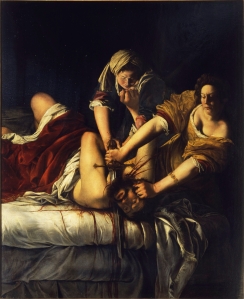Simon Vouet’s The Rape of Europa is probably not an allegorical painting in the strictest sense but it does carry meaning beyond the painting of a beautiful woman resting on a snow white bull.
This is the story of the abduction, rather than rape, of the beautiful Europa by the god Zeus who disguised himself as a bull in order to hide amongst Europa’s father’s herd. When she climbed on his back, he swam off Crete where he made her the Queen and presumably had his way with her.
The painting is a typically baroque fantasy filled with beautiful light surfaces and with everyone swooning all over the place. Even the bull has a strange moon-calf expression on his face.
The painting shows Vouet at his best with the subtle gradations of light setting off the forms of Europa, the bull and the two handmaidens. But as a painting, it is verging towards prettiness.
Saturn, Conquered by Amor, Venus and Hope shows the Roman god Saturn who symbolises Time. The beautiful young girl who has seized one of the god’s wings is Hope, whose attribute is the anchor at her feet. The woman pulling Saturn’s greying hair is Truth.
Above this group is Fame blowing into a long trumpet and Chance who is carrying the attributes of power which means she can also be identified with Fortune. Next to the god, on his left, there is a “putto”, a winged cherub. (http://www.historyandarts.com/fichas/obras/5290.htm)
In style, content and composition, this painting is very similar to The Rape of Europa. Both draw on Greek or Roman mythology, the painting is filled with gorgeously apparelled and buxom young woman wafting through the air blowing trumpets.
All very fanciful and all very baroque.
There are striking similarities in Vouet’s use of light in the two paintings. It is used to highlight the clothing and the bodies of the young women all of whom are bathed in soft pastel tones. By contrast, Saturn is a slightly darker figure, darker skinned and casting more shadow.
The structure of the painting appears to detract from its dramatic impact. The upper part of the painting which features the four young allegories is a diagonal whose energy is directed towards to the right-hand side of the painting. However, Hope who has holding onto Saturn’s wings changes the direction of energy, as does Truth who has hold of his hair. These two figures refocus and redirect the energy of the painting back towards the fallen figure of Saturn.
The way in which the shift of the energy is handled is masterful. The two figures in the centre of the painting effectively redirect the entire energy of the composition while remaining integrated with both top and bottom sections of the painting. But this structure does tend to take the any dramatic tension out of the painting.
Father Time overcome by Love, Hope and Beauty is a far more serious work. The accomplished handling of light is still there but there is a much greater sense of dramatic energy in this painting. There is also a sense of realism that is lacking in The Rape of Europa. Perhaps it’s the bull.
Certainly everybody seems to be focusing on the task of beating up on Father Time and there are no handmaidens wafting in midair.
The figures of the two women, one giving old Father Time a good wacking and the other holding him by the hair create a tension that creates a balance around the figure of the man in the centre of the painting.
The baroque aspect of the painting is that it is based on the fanciful notion that love hope and beauty will outlast time. Shakespeare knew better when he wrote:
Golden lads and girls all must,
As chimney sweepers come to dust.
The Rape of Europa and Saturn, Conquered by Amor, Venus and Hope are fanciful genre pieces. They reflect Vouet’s role as a decorative painter in the court. The depiction of the women is entirely traditional: decorative and idealised
Father Time overcome is an entirely different piece of work. The woman are warriors, powerful and vindictive and use of light and colour in this painting is reminiscent of the much darker painting of Judith slaying Holofernes by Artemisia Gentileschi.
